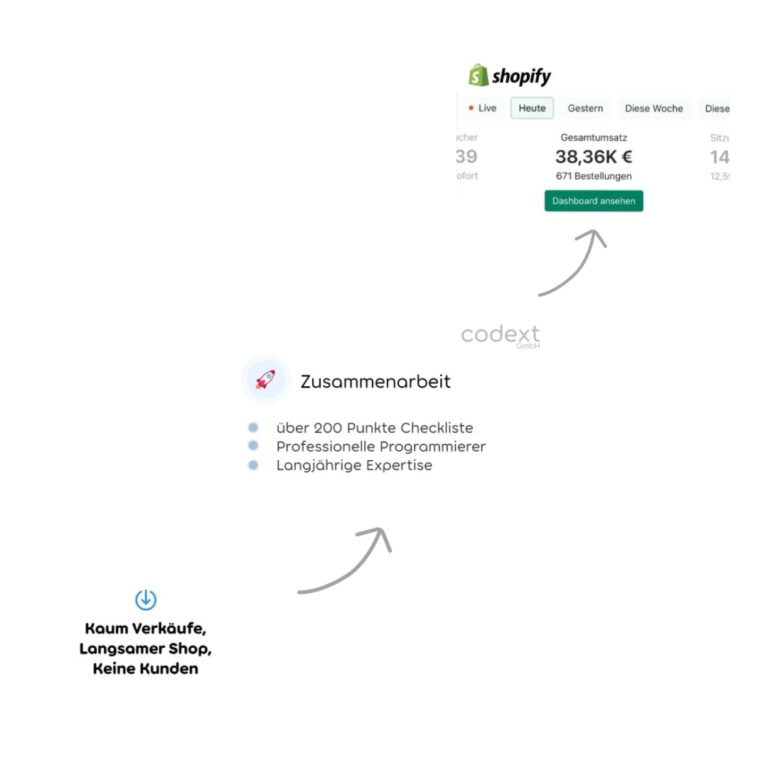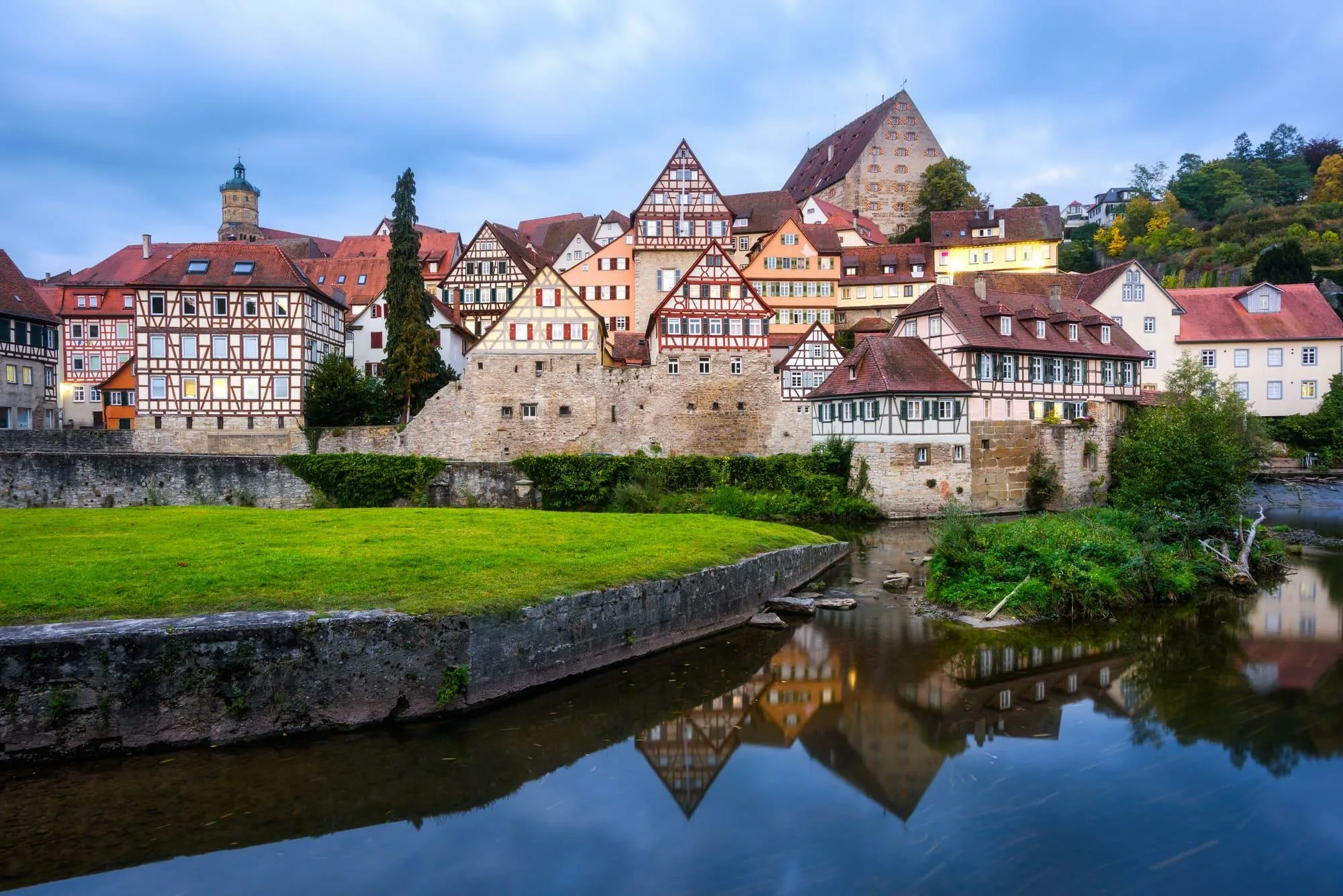Offizielle Shopify Agentur
Mit Shopify zu
einem Online Shop
der endlich funktioniert.
Wir verwandeln Herausforderungen in Chancen
und sorgen für einen reibungslosen Übergang zu einer leistungsstarken, skalierbaren und nutzerfreundlichen Plattform: Shopify.

Mehr als 20+ Shops
zu Shopify migriert








- +12% mehr Conversions
- erfahrenes Expertenteam
- ab 500K Jahresumsatz
DAS PROBLEM
Was Dich davon
abhält, mehr Umsatz
zu machen
Als Shopbetreiber kennst du bestimmt die folgenden Probleme.
PROBLEM 01
Schlechte Ladezeiten
Du leidest unter frustrierend langsamen Ladezeiten, die Kunden abschrecken? Oft liegt es an mangelnder Skalierbarkeit und ungeeignetem Hosting, die deinen Online-Erfolg und Kundenverkehr behindern.
PROBLEM 02
Hoher Wartungsaufwand
Fühlst du dich überwältigt von dem ständigen Kampf mit Shop-und Plugin-Updates, die nie zu enden scheinen und oft zu Kopfschmerzen bei der Kompatibilität führen? Diese fortwährenden technischen Herausforderungen können deine wertvolle Zeit und Ressourcen verschlingen.
PROBLEM 03
Fehlende Funktionen
Du bist frustriert über die begrenzten ‚Out-of-the-Box‘-Funktionen und den hohen Programmieraufwand, der erforderlich ist, um deinen Shop deinen Wünschen anzupassen? Ganz zu schweigen von den enttäuschenden Drag&Drop-Buildern, die deine Kreativität
einschränken?

„Die gute Nachricht: Wir können diese Probleme nachhaltig lösen, indem wir deinen Shop zu Shopify migrieren, so wie wir es schon mit zahlreichen anderen zufriedenen Kunden gemacht haben.“
Daniel Ehrhardt
Geschäftsführer, Codext GmbH

DIE LÖSUNG
Eine Migration zu Shopify
Dem Online Shop System dem über 120.000 Händler allein in Deutschland vertrauen (darunter Unternehmen wie: Volkswagen, Media Markt, Jägermeister, Reformhaus)
HÖHERE CONVERSION RATE
Shopify hat zahlreiche Mechanismen, die einen enormen Vorteil gegenüber Shopware, Magento & WooCommerce haben und sich damit positiv auf die Conversion Rate auswirken.
DER AM BESTEN KONVERTIERENDE CHECKOUT DER WELT
Der Shopify Checkout bietet dir durchschnittlich eine um 15 % höhere Conversion als andere Commerce-Plattformen.
GERINGER WARTUNGSAUFWAND
Shopify kümmert sich um die Wartung der Server, Software-Updates und Sicherheitspatches.
POINT OF SALE
Ein POS-System, mit dem Kund:innen auf ihre Weise einkaufen können, vom Onlineshop bis zur Kasse in der Filiale.
ERREICHE NEUE LEADS
Finde neue Kundschaft mit den Tools von SEO, Social Media und Content Marketing, mit denen du deine Kund:innen dort erreichst, wo sie sind.
CASE STUDIES
Erfolgreiche
Kundenprojekte
Eindrückliche Case Studies von Kunden, die nach einer Migration zu Shopify endlich mehr Zeit für die wichtigen Dinge haben.

Relaunch
Solakon ist bekannt für das günstigste Balkonkraftwerk Deutschlands! Durch den Relaunch konnten wir den Shopify Shop nochmal ordentlich boosten.
- 30% höherer Warenkorbwert
- 9% höhere Conversion Rate
- Bessere Kundenbindung


Migration von Magento zu Shopify
Für ggmgastro haben wir eine erfolgreiche Migration von Magento zu Shopify durchgeführt und eine SAP-Schnittstelle entwickelt.
- 3% höhere Conversion Rate
- Erhöhte Marktreichweite dank Mehrsprachigkeit
- Marketing Optimierung durch Klaviyo


Migration von Shopware zu Shopify
Sportnahrung Wehle hatte es mit Shopware an Anpassungsmöglichkeiten der Produktdetailseiten gefehlt. Zudem war die Geschwindigkeit mehr als schlecht.
- 6% mehr Verkäufe
- 11% höhere Kundenbindung
- 140% schnellere Ladezeit


Migration von WooCommerce zu Shopify
Hochbeet.com hatte aufgrund seiner bestehenden WooCommerce-Plattform mit einer veralteten und technisch limitierten Online-Präsenz zu kämpfen. Wir haben ein neues CI entwickelt und den Shop nahtlos zu Shopify migriert.
- 2% höhere Conversion Rate
- Optimierte Customer Journey
- Signifikante Verbesserung der Ladezeit

Aus der Heimat
Die Codext
Wir als Shopify Agentur haben uns darauf fokussiert, schlecht performende Online Shops
nahtlos zu Shopify zu migrieren. Dabei steht Dir unser Experten Team von Anfang an zur Seite.
Und auch nach der Migration freuen wir uns, weiter mit Dir zu arbeiten und Deinen Shopify
Shop zu skalieren und Dich bei Launches zu begleiten.

STANDORT
Frankenstraße 10, 74549 Wolpertshausen
ÜBER UNS
Lerne dein
Team kennen

Daniel Ehrhardt
Head of Development

Leon Gürntke
Head of eCommerce

Sebastian Sanwald
eCommerce Manager

Michelle Tuncer
Head of Finance
1. KONZEPTION
Wir entwickeln gemeinsam mit Dir einen individuellen Plan für Deinen Shop. Dies umfasst die Analyse Deines aktuellen Shops und das Verstehen Deiner Geschäftsziele, um eine erfolgreiche Shopify-Strategie zu entwerfen.
2. DATENMIGRATION
Wir übertragen sorgfältig alle wichtigen Daten wie Produktinformationen, Kundenkonten und Bestellhistorie von Deiner aktuellen Plattform sicher auf Shopify.
3. GRUNDAUFBAU
In dieser Phase erstellen wir die Grundstruktur Deines Shopify-Shops, einschließlich des Designs, der Navigationsstruktur und der Integration grundlegender Funktionen.
4. ERWEITERUNG DES FUNKTIONSUMFANGS
Wir passen Deinen Shop an, indem wir zusätzliche Funktionen und Anpassungen hinzufügen, die speziell auf Deine Bedürfnisse und die Deiner Kunden zugeschnitten sind.
5. OPTIMIERUNG
Hier konzentrieren wir uns auf die Feinabstimmung, um die Benutzererfahrung zu verbessern, die Ladezeiten zu verkürzen und die Suchmaschinenoptimierung (SEO) zu verbessern.
6. FINALISIERUNG & LAUNCH
Zum Abschluss überprüfen wir alles gründlich und stellen sicher, dass Dein Shop bereit für den Start ist. Nach dem Launch bieten wir Unterstützung, um einen reibungslosen Betrieb zu gewährleisten.
ZUSAMMENARBEIT ANFRAGEN
Der Beginn unserer
Zusammenarbeit
SCHRITT 01
SHOP-ANALYSE
Durch unsere Shop-Analyse erhältst du einen ausführlichen Bericht über das Optimierungspotenzial deines aktuellen Shops. Einfach auf den Button „Jetzt Shop-Analyse anfordern“ klicken.
SCHRITT 02
BERATUNGSGESPRÄCH
Wir zeigen dir anhand der Shop-Analyse auf, welche Vorteile sich speziell für dich und deinen Shop ergeben und wie eine Migration bei uns abläuft.
SCHRITT 03
ONBOARDING
Wenn du dich nach der Erstberatung entscheidest, gemeinsam mit uns deinen aktuellen Shop auf Shopify zu migrieren starten wir mit dem Onboarding.
Du kannst schnell herausfinden, ob wir dir helfen können. Wenn du Inhaber/in eines Unternehmens bist, sind wir zur Stelle. Um herauszufinden, wie wir dir helfen können, kannst du ein unverbindliches Erstgespräch mit uns buchen. So erhältst du Klarheit darüber, ob und wie wir dir helfen können.
Shopify bietet eine nutzerfreundliche, flexible und skalierbare E-Commerce-Plattform, die ideal für Geschäfte jeder Größe ist. Mit Shopify kannst du von einer verbesserten Benutzererfahrung, einer Vielzahl an verfügbaren Apps zur Erweiterung deines Shops und einer robusten, sicheren Infrastruktur profitieren. Außerdem ermöglicht Shopify eine einfache Verwaltung deines Online-Geschäfts, was dir Zeit spart und den Betrieb effizienter gestaltet.
Die Codext GmbH verfügt über ein erfahrenes Team von Experten, die sich auf die Migration von Online-Shops spezialisiert haben. Wir bieten einen reibungslosen Übergang mit minimalen Ausfallzeiten, um sicherzustellen, dass dein Geschäft weiterhin effizient läuft. Mit unserer umfassenden Kenntnis der Shopify-Plattform können wir deinen Shop nicht nur migrieren, sondern auch anpassen und optimieren, um das Beste aus deinem neuen System herauszuholen. Unsere Expertise in diesem Bereich garantiert eine qualitativ hochwertige und stressfreie Migration.
Wir beginnen mit einer detaillierten Analyse deines aktuellen Shops, um deine spezifischen Anforderungen und Ziele zu verstehen. Anschließend planen wir einen maßgeschneiderten Migrationsplan, der sicherstellt, dass alle wichtigen Daten, wie Produktinformationen, Kundenkonten und Bestellhistorie, nahtlos zu Shopify übertragen werden. Während des gesamten Prozesses stehen wir dir mit unserem Support zur Seite und sorgen dafür, dass der Übergang so reibungslos und effizient wie möglich verläuft. Nach der Migration bieten wir auch weiterhin Unterstützung an, um sicherzustellen, dass du das volle Potenzial deines neuen Shopify-Shops ausschöpfen kannst.
Der USP (Unique Selling Proposition) der Codext GmbH liegt in ihrer spezialisierten Expertise und ihrem umfassenden Serviceangebot für die Migration von Online-Shops zu Shopify. Hier sind einige Schlüsselaspekte, die die Codext GmbH besonders machen:
1. Spezialisierung auf Shopify-Migrationen: Die Codext GmbH hat sich auf die Migration von Online-Shops von Plattformen wie Magento, Shopware und WooCommerce zu Shopify spezialisiert. Diese Fokussierung ermöglicht es dem Team, tiefgreifendes Wissen und Fachkenntnisse in diesem Bereich zu entwickeln.
2. Maßgeschneiderter Migrationsprozess: Jeder Kunde und jedes Projekt wird individuell behandelt. Codext GmbH versteht, dass kein Online-Shop identisch ist, und passt den Migrationsprozess entsprechend den spezifischen Bedürfnissen und Anforderungen des Kunden an.
3. Minimierung von Ausfallzeiten: Durch effiziente Planung und Durchführung der Migration sorgt die Codext GmbH dafür, dass die Ausfallzeiten deines Online-Shops auf ein Minimum reduziert werden, was essentiell ist, um den Geschäftsbetrieb aufrechtzuerhalten und Umsatzverluste zu vermeiden.
4. Umfassende Nachbetreuung: Nach der Migration bietet die Codext GmbH weiterhin Unterstützung an, um sicherzustellen, dass der Kunde das volle Potenzial seiner neuen Shopify-Plattform ausschöpfen kann. Dies umfasst technischen Support, Beratung zur Optimierung des Shops und Anpassungsmöglichkeiten.
5. Erfahrene und qualifizierte Experten: Das Team von Codext GmbH besteht aus erfahrenen Entwicklern, Designern und E-Commerce-Experten, die über umfassende Kenntnisse in ihren jeweiligen Fachgebieten verfügen.
6. Kundenzentrierter Ansatz: Die Zufriedenheit des Kunden steht im Mittelpunkt aller Aktivitäten der Codext GmbH. Das Unternehmen legt großen Wert darauf, zuzuhören und auf die individuellen Bedürfnisse seiner Kunden einzugehen.
Diese Kombination aus Fachwissen, kundenspezifischer Serviceausrichtung, technischer Kompetenz und einem starken Fokus auf Qualität und Kundenzufriedenheit bildet den USP der Codext GmbH.



